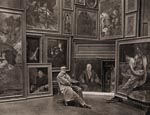Victorian Artists in Photographs
Matthew Dennison enjoys tantalising glimpses of the world of G. F. Watts in an exhibition of photographs at the Watts Gallery in Compton, Surrey


The journalist Harry How knew his readers. In the Strand Magazine, he described the excitement felt by the ordinary man peering inside the home of a famous artist. It was the end of the 19th century. Artists in significant numbers enjoyed success, renown and immense riches. Invariably, they built themselves houses that broadcast their achievements, and opened those houses to photo-graphers and an eager public.
Advances in printing made it possible for such magazines to offer their readers tantalising glimpses of this gilded world. With breathless orotundity, Mr How opined: 'Outsiders are always curious about artists and their surroundings; to them the sanctum sanctorum of the painter's house is the mysterious place, draped in tapestry [the studio]. It is the sacred meeting ground of a secret society... a laboratory in which ideas are boiled up, and turned out on canvas by magic, the paint-pot and brushes being the wizard's apparatus. 'What the Strand did on a large scale, F. G. Stephens, in his monograph of 1884, Artists at Home, with photographs by Joseph Parkin Mayall, did on a smaller, more rarefied scale: Stephens' book was published in an edition of only 500. A number of Mayall's works are included in an exhibition at The Watts Gallery.
The show of almost 160 photographs many of them small-scale cartes-de-visite serves the useful purpose of contextualising George Frederick Watts. The Grand Old Man of Victorian painting, Watts resisted becoming part of any of the century's artistic movements. Both during and after his lifetime, he apparently stood alone, independent of the two powerhouses of British 19th-century blockbuster painting, the pre-Raphaelites and the Olympians. He has his own museum and, until the 1930s, enjoyed a room exclusively devoted to his work at the Tate. It is easy to view Watts' painting in a vacuum the creation of a lonely visionary operating in isolationist freefall, but this is misleading.
As did many of his contemporaries, Watts recognised popular fascination with the artistic world. He allowed himself and his house to be photographed repeatedly, and the images are as strenuously considered as any self-portrait. To the modern eye, Watts is in fancy dress, garbed in tent-like, quasi-ecclesiastical robes and sporting a silk skull cap. He does not, of course, smile, nor even seek to meet the viewer's gaze. But he embodies a sense of gravitas, his unwieldy costume forging a connection across centuries with earlier masters such as Titian; and in the otherworldliness of his appearance is a potent suggestion of the artist's role not simply as recorder but seer. Such images set Watts apart from the popular herd in a manner that is positive and celebratory. Deliberate 'differentness' of appearance characterises the majority of the artists included in the present exhibition eccentricities of dress and 'artistic' indulgence in extreme hairstyles or beard fashions.
Earlier this year, the Watts Gallery found itself the surprise recipient of a munificent bequest. Gallery trustee and ex-Warner Music chairman Rob Dickens bought in its entirety the archive of 4,500 photographs assembled by the Maas Gallery and immediately gave the whole lot to the gallery. It is from this collection that the present exhibition is drawn. The show focuses not only on artists, but on their models notably Lord Leighton's favourite Dorothy Dene shown with their friends and family. Here are glimpses into a world that is not merely Watts's, nor even Victorian, but everlasting: Edward Burne-Jones in the role of grandfather, dandling on his knee the future novelists Denis Mackail and Angela Thirkell, and the last meeting of Ruskin and Holman Hunt, poignantly preserved for ever in silver bromide.
'Victorian Artists in Photographs: G. F. Watts and his World', the Watts Gallery, Compton, Surrey (www.wattsgallery.org.uk; 01483 810235), from September 15 to December 31
Exquisite houses, the beauty of Nature, and how to get the most from your life, straight to your inbox.
Country Life is unlike any other magazine: the only glossy weekly on the newsstand and the only magazine that has been guest-edited by His Majesty The King not once, but twice. It is a celebration of modern rural life and all its diverse joys and pleasures — that was first published in Queen Victoria's Diamond Jubilee year. Our eclectic mixture of witty and informative content — from the most up-to-date property news and commentary and a coveted glimpse inside some of the UK's best houses and gardens, to gardening, the arts and interior design, written by experts in their field — still cannot be found in print or online, anywhere else.
